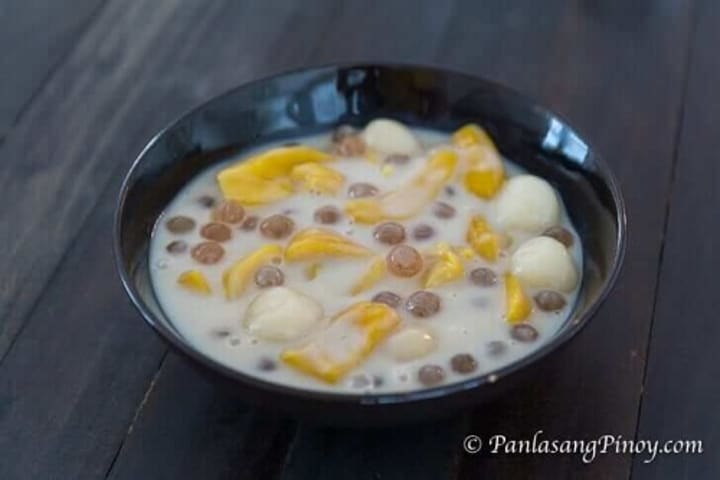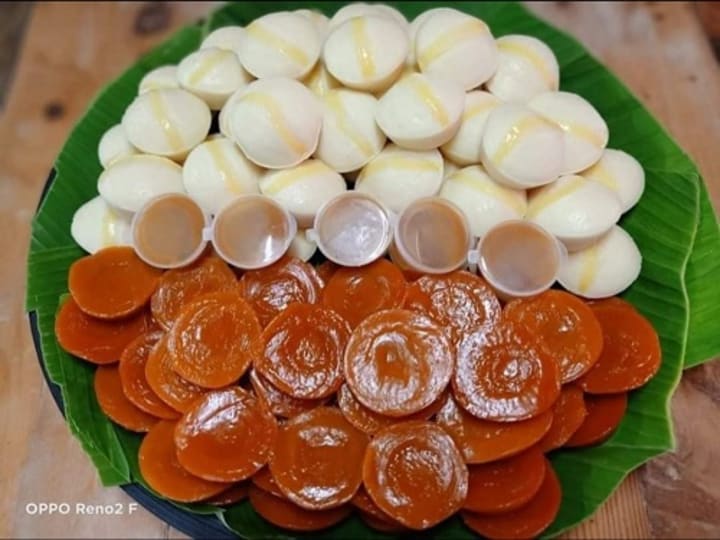MY FAVORITE FILIPINO DESSERT
The Filipino Dessert

We all know that Filipinos are naturally hospitable and gentle people, but in case you don’t know—we are certified food lovers, too.
Filipino desserts are heavily influenced by so many.
But what’s emerged from all these influences is a cuisine you can identify on sight: a rich, unique, flavorful, and utterly delicious variety of dishes singular to the Philippines.
You may eat the same dessert twice in different parts of the country and have completely different experiences.
But Filipino food plays a huge role in showcasing the country’s rich culture. Even if you don’t have a sweet tooth, you’re bound to find something that will surprise and excite your palate.
Here are some of my favorite Filipino desserts back in my homeland, perfect for sweet summer nights, breakfast (agahan) or an afternoon snack (merienda).

Biko - (pronounced bee-koh), a rice cake, is a native Filipino delicacy or 'kakanin' where glutinous rice is cooked with coconut milk and brown sugar then topped Latik.
The latik can be either in curd form or syrup. Traditionally, biko is served on a bilao, a round wooden bamboo tray, lined with coconut-oiled banana leaves, and is a popular dessert for every special occasion like birthdays, reunions and fiestas.

Bibingka - Bibingka is a traditional Filipino dessert that is predominantly sold on the streets to celebrate the Christmas season, specifically after simbang gabi (or Christmas night mass).
Like other rice cakes in Filipino culture, puto or biko, this kakanin (or cake) is one of the most popular desserts. Bibingka is traditionally made on the streets of the Philippines in terracotta pots lined with banana leaves and cooked over charcoal. While the origin of bibingka is not quite known, there are similarities between Indonesian and Filipino bibingka, since they are both baked rice cakes.

Maja Blanca - Maja Blanca is a Filipino dessert made from coconut milk, cornstarch, and sugar. Often called Coconut Pudding, this luscious dessert is easy to make and the ingredients are very common.
To back up and understand the origins of this delicious dish, I would have to take you back in time to when The Philippines was a bigger mix of cultures. During the time when Spain had a lot of influence on our foods and language, you find delicious dishes that came from this.
Maja Blanca has a rich historical background, having originated from Spain and was adapted from the traditional Spanish holiday referred to as manjar blanco, which actually means white delicacy.
Now in our days Filipino holidays aren’t truly complete in my homeland without having the Maja Blanca on the table. I have grown up seeing these delicious dishes at all of our holiday parties and commonly served at Fiestas, holidays and special occasions.

Sapin Sapin - Sapin-Sapin is a 3 layered colorful rice cake. A Filipino snack made from rice flour, coconut milk and sugar topped with curdled coconut cream. A favorite by many. Isn't the color pleasing to your palate?
It's colourful, it's delicious, it's sticky! One of the best rice cakes Philippines has to offer. Sapin sapin is a sticky rice cake prepared with mutliple layers flavours with ube, jackfruit and coconut topped with toasted shredded coconut meat.
Sapin-sapin is a sticky rice cake from the Philippines. It originated in a northern province called Abra. The name came from the word sapin, which means sheets or layer. It is also the main characteristic of this rice cake, its vibrant multi coloured layers. It is made out of steamed glutinous rice flour served with latik and/or toasted coconut. Usually it is made with 3 to 4 layers which have a slight variation in taste and texture, the purple layer usually consists of purple yam, the orange layer have a hint of aniseed, also in other areas they use jackfruit as it flavour instead, the white layer contains young coconut meat and green is flavoured with pandan.
It is a Filipino pride, a Filipino native dessert Sapin-Sapin.

Ginataang Bilo-bilo - Ginataang Bilo-bilo with Langka is a Filipino snack dish. It is composed of glutinous rice balls (locally known as bilo-bilo), coconut cream, sugar, sago pearls, and ripe jackfruit. Some people consider this as a simplified version of the Ginataang halo-halo.
This is usually and traditionally eaten hot, while others prefer eating them after refrigeration.
Nothing spells sheer comfort like a bowl of warm, thick, rich ginataang bilo-bilo. The glistening snowy white creamy coconut milk clings to the rice balls and together with the fruity langka strips, the entire experience is simply scrumptious.

Puto and Kutsinta - Puto is a Filipino steamed cake snack that is served any time of the year. It is the perfect dish to bring to a gathering or potluck because it’s easy to eat and to transport. It is traditionally made from ground rice and can be eaten by itself, with butter or grated coconut.
Kutsinta is a native sweet Filipino snack that is made by steaming sticky rice. It is brown or reddish in color because it is sweetened with brown sugar that is further enhanced using annatto or achuete. It is usually eaten with grated coconut.
I remember when I was a kid, I would wake up to the sound of a peddler howling in the streets, early in the morning to sell his Puto and kutsinta for breakfast.
We called them Auntie or Uncle as a sign of respect.
both puto and kutsinta are traditionally made from rice, but came out to be so different.
They are also both steamed, but puto is made from regular sweet rice while kutsinta is from glutinous or sticky rice. One thing they share in common is that they are both delicious and make great snacks or breakfast.

Tupig or tinupig - Snipping the ends of the coconut leaves and a little bit of wrapping was my part, but I wasn’t good at wrapping back then. The rice cake comprises ground glutinous rice flour mixed with coconut milk, coconut strips, and muscovado sugar.
Combined together definitely makes you ask for more.
Most of all, what really makes tupig unique is the way the people cook it in my homeland. Instead of the usual steaming or mixing in the pan until you reach the desired consistency, the mixture is wrapping in banana leaves, and you grill them in charcoals.
This process gives the dish a smoky and charred flavor, which complements the sweet flavor and the texture of this delicacy. And the finished product, without even tasting it, is enough to tickle someone’s curiosity upon glancing at it.
About the Creator
Roy Flores
Writing has always be a part of my life.It Is a dream,my passion and my hobby that become a reality.






Comments
There are no comments for this story
Be the first to respond and start the conversation.